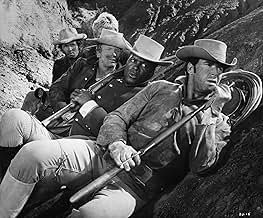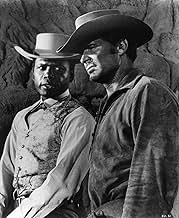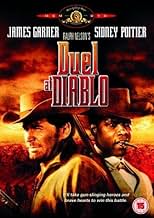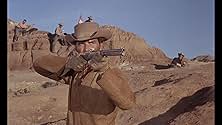VALUTAZIONE IMDb
6,5/10
4649
LA TUA VALUTAZIONE
Nel territorio di Apache, un uomo cerca l'assassino della moglie indiana e una casalinga abbandona il marito per raggiungere la tribù del suo amante Apache.Nel territorio di Apache, un uomo cerca l'assassino della moglie indiana e una casalinga abbandona il marito per raggiungere la tribù del suo amante Apache.Nel territorio di Apache, un uomo cerca l'assassino della moglie indiana e una casalinga abbandona il marito per raggiungere la tribù del suo amante Apache.
- Regia
- Sceneggiatura
- Star
- Premi
- 1 candidatura in totale
Ralph Nelson
- Col. Foster
- (as Alf Elson)
Armand Alzamora
- Ramirez
- (non citato nei titoli originali)
Ralph Bahnsen
- Trooper Nyles
- (non citato nei titoli originali)
Timothy Carey
- Deputy Clem
- (non citato nei titoli originali)
Jeff Cooper
- Trooper Casey
- (non citato nei titoli originali)
Kevin Coughlin
- Norton
- (non citato nei titoli originali)
Robert Crawford Jr.
- Trooper Swenson - Bugler
- (non citato nei titoli originali)
Recensioni in evidenza
in an age when black actors were confined to black roles, this film shows Poitier in a role that could easily have been played by a white actor-plus he's the coolest dude in the movie.
Bill Travers doesn't have to do an American accent.
this was from a time that people believed that there could be major characters with foreign accents in the USA who weren't villains.
Of course the USA at this time, and at any time, had plenty of odd accents. Except in movies.
The credits are waaaay more imaginative that you'd normally expect.
The music is highly "different" The camera-work is very strange- all those overhead shots.
I love this movie, and is a film I can watch again and again. It's very stylised-the lines are delivered like they were from a comic book.
You know-the sort of thing Quentin T "discovered"
Bill Travers doesn't have to do an American accent.
this was from a time that people believed that there could be major characters with foreign accents in the USA who weren't villains.
Of course the USA at this time, and at any time, had plenty of odd accents. Except in movies.
The credits are waaaay more imaginative that you'd normally expect.
The music is highly "different" The camera-work is very strange- all those overhead shots.
I love this movie, and is a film I can watch again and again. It's very stylised-the lines are delivered like they were from a comic book.
You know-the sort of thing Quentin T "discovered"
"Duel at Diablo" filmed in 1966, has a cast of both American and international players and touches of violence coupled with prejudices. It makes for an interesting mix and provides the viewer with a tense depiction of the usual struggles of the Apaches against the US Cavalry. James Garner plays Jess Remsberg, an Indian scout now out looking for the man or men that raped and killed his Indian wife. Sidney Poitier adds an excellent portrayal of a former Army sergeant who has quit the job of soldering in exchange for breaking horses, and selling them to the Army. Bill Travers and Bibi Anderson provide the international flavor in the cast, and Dennis Weaver gives the viewer a chance both to detest him and feel some sorrow for his warped prejudices toward those he considers inferior or below his status.
The group of troopers heads out across the desert to another fort in the area, but are headed off by a group of Apaches that have jumped their reservation. Garner does find out the identity of the man who was responsible for the rape/killing of his Indian wife, but in order to extract his revenge, he must first make it to the canyon of Diablo and rescue the beseiged group of Army troopers from being killed by the Apaches.
Good, tense story, sweeping vistas of the Utah landscape, and two actors, Garner and Poitier, delivering masterful performances.
The group of troopers heads out across the desert to another fort in the area, but are headed off by a group of Apaches that have jumped their reservation. Garner does find out the identity of the man who was responsible for the rape/killing of his Indian wife, but in order to extract his revenge, he must first make it to the canyon of Diablo and rescue the beseiged group of Army troopers from being killed by the Apaches.
Good, tense story, sweeping vistas of the Utah landscape, and two actors, Garner and Poitier, delivering masterful performances.
Like the other reviewer of this movie, I, too, was a young child when I first saw this movie. It was around 1975 and it made quite an impression on me. My father, Bob Weissman, who loved the music in the film, first played the soundtrack for me. It is hypnotic and stirring -just excellent. The movie's storyline is not intricate, but what it lacks in depth, it makes up for with some suspense, good cinematography and of course, great music. James Garner is charismatic just like he is in "Support Your Local Sheriff" and Sydney Poitier, Dennis Weaver and Bibi Anderson fill their roles adequately. Overall, a good rental for a rainy (or snowy) afternoon or evening.
Caught between Hollywood's traditional western genre and the revisionist western styles of the late 1960s and 1970s, Duel at Diablo seems both a little behind and ahead of its time. As an old-fashioned western, Duel at Diablo has traditional cavalry vs. Indian story line and well-executed, exciting battle scenes. Beyond this, the film also addresses racism and oppression towards native Americans in a complex and non-sentimental manner, through various inter-linked sub-plots. While the Apaches may be cruel and the instigators of attacks, it is clear that this is only because they have been oppressed to the point where they have no other resort. This is not a battle between "good guys" and "bad guys" and in the end nobody wins. Perhaps, the film could have delved a little deeper into the social and ethical issues it raises. At times, it appears that the movie itself is unsure whether it is primarily an action film or a message film. However, this is also the movie's strength as its messages do not detract from the story and action, and never appear simplistic or preachy as is often the case in westerns that take a sympathetic perspective on the plight of native Americans.
Meanwhile, the excellent, rhythmic and moody musical score by Neil Hefti, while unusual for a western, is well suited to accompanying the unrelenting action sequences and conveying the tragedy and doom of a society and individuals caught in a vicious cycle of conflict and racism. The casting of the film further contributes to making Duel a Diablo a strong, atypical western. James Garner, who up to then had always played amiable leading men, sheds his typical persona to effectively portray a tough and rugged frontier scout, bent on avenging the murder of his Indian wife. Equally effective and very cool-looking in a 3-piece suit, Sidney Poitier is an army sergeant turned businessman, whose color is on the surface only incidental to the story beyond a couple of subtle inuendos (that said, it is really left to the viewer's interpretation whether his race is significant to the story, and it is somewhat ironic to see a black man taking charge among a regiment of white soldiers in shoot-outs against Indians). Europeans Bibi Anderson and Bill Travers also seem strangely out of place, respectively portraying what could be a Scandinivian emigrant and a Scottish-born American officer. And Dennis Weaver, who up to that time was mainly known as a simple good guy in TV's Gunsmoke plays the part of a nuanced villain. Add to this the beautiful cinematography of wide desert landscapes, and Duel at Diablo is a superior, exciting, and socially-conscious western, not a great one, but certainly unique.
What makes this film interesting albeit unconventional are various themes that swirl beneath the main story line. Made at the time when the Civil Rights movement was in full swing, the film subtly touches on issues that were important during the 60s (e.g. racial tolerance, treatment of women and minorities). The film also has a brutal hard edge to it when it comes to the violence, death and the mayhem that takes throughout. The score gives a sense of desperation and inevitability which enhances its hard edge. Unlike many films of the genre, there is no clear cut protagonist or antagonist. The characters are realistic and more than mere two-dimensional cartoon characters for which the viewer could identify with. Overall, it is a thought provoking film that deserves a look in.
Lo sapevi?
- QuizJames Garner's first western since leaving Maverick (1957) and Sidney Poitier's first theatrical western.
- BlooperAs Willard hands his wife a gun, he says there are two cartridges in gun. However, it can be seen that all six chambers are loaded.
Bullet noses can be seen in the chambers on the left side of the cylinder but a minute or so later, the right side is on camera and shows 3 empty chambers.
- Citazioni
Ellen Grange: They all think that any decent woman would prefer to die than live as an Apache squaw. Maybe they're right.
Jess Remsberg: Death comes soon enough. Anyone who hurries it is a damn fool.
- Curiosità sui creditiThe United Artists logo is sliced off the screen with a bloody Calvary Saber, slicing an "X" across the screen, revealing the opening scene. At the end, the same saber slices the live picture away, as (sort of) a fade out.
- ConnessioniFeatured in Rubare alla mafia è un suicidio (1972)
I più visti
Accedi per valutare e creare un elenco di titoli salvati per ottenere consigli personalizzati
- How long is Duel at Diablo?Powered by Alexa
Dettagli
- Tempo di esecuzione1 ora 43 minuti
- Colore
- Proporzioni
- 1.66 : 1
Contribuisci a questa pagina
Suggerisci una modifica o aggiungi i contenuti mancanti

Divario superiore
By what name was Duello a El Diablo (1966) officially released in India in English?
Rispondi




































